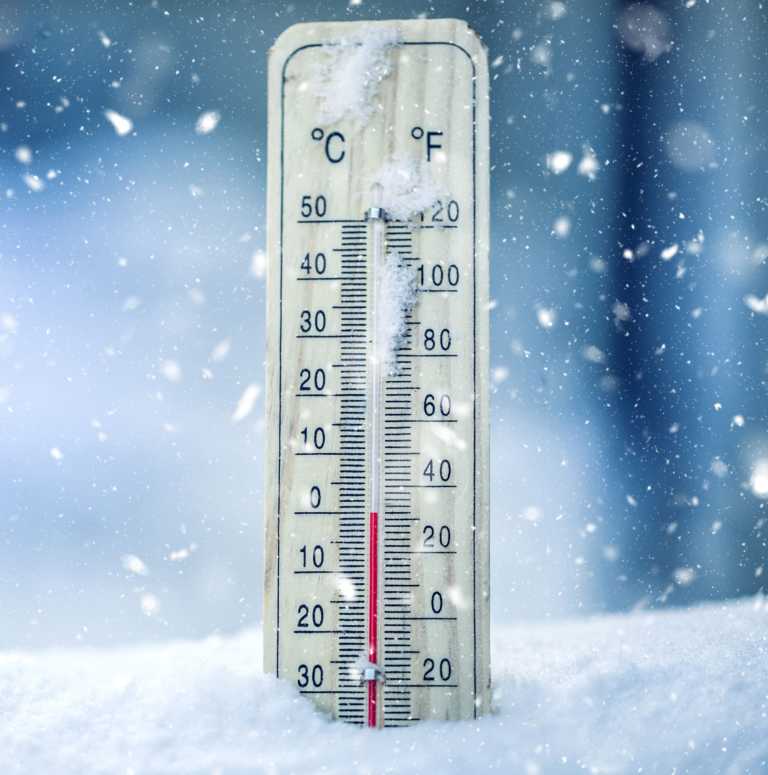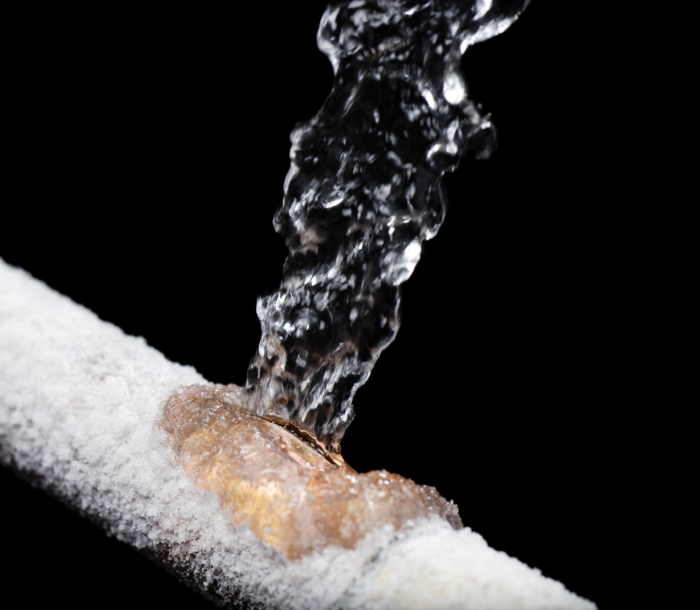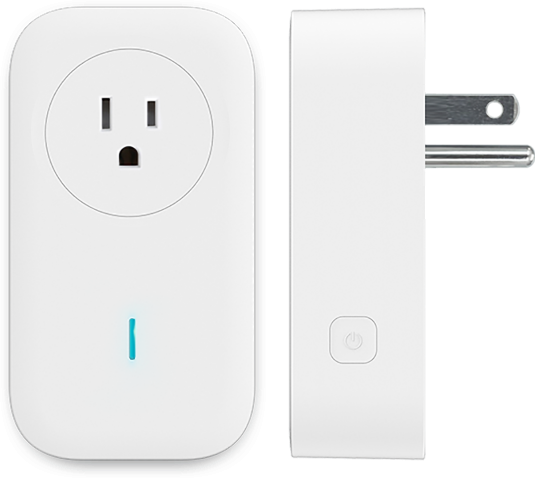Prevent Frozen Water Pipes on Your Construction Site
How to Prevent Frozen Water Pipes on Your Construction Site:
UbiBot Data Loggers and Smart Plugs Can Help
UbiBot Data Loggers and Smart Plugs Can Help
Winter construction sites and renovation projects face a significant problem: frozen pipes. Beyond the inconvenience of plumbing disruptions, the dangers and costs associated with frozen water pipes can escalate rapidly, impacting both timelines and budgets. Fortunately, preventing pipes from freezing is fairly straightforward.
In this blog, we will explore the potential hazards, financial implications, and prevention methods to safeguard projects against winter temperatures. We will also explore the benefits of using UbiBot wireless temperature loggers and smart plugs on your winter construction site to monitor temperatures.
Conditions that Contribute to Frozen Pipes
The risks of frozen water pipes generally begins when outside temperatures drops to around 20 degrees Fahrenheit (-6 degrees Celsius) or lower. However, the actual freezing point of water pipes can vary depending on several factors. Here are some considerations:
1. Insulation Levels: Well-insulated water pipes are less susceptible to freezing. Adequate insulation helps maintain higher temperatures within the pipes, reducing the risk of freezing even in colder conditions.
2. Wind Chill Factor: Wind can significantly impact the rate at which water pipes freeze. Even if the air temperature is above freezing, wind can cause pipes to freeze more quickly by removing the protective layer of warm air surrounding them.
3. Exposure to Cold Air: Water pipes that are exposed to cold air, especially if they are not insulated, are more likely to freeze. This includes pipes in unheated or poorly insulated areas of a building or construction site.
4. Length of Exposure: Prolonged exposure to freezing temperatures increases the risk of pipes freezing. Extended periods of cold weather can lead to gradual cooling of pipes and, eventually, freezing.
5. Type of Pipe Material: Different pipe materials have varying resistance to freezing. Plastic pipes, for example, may be more resilient than metal pipes because they can expand to some extent without bursting.
6. Water Flow: Running water is less likely to freeze than still water. In cold conditions, allowing faucets to drip slightly can prevent water from becoming stagnant within the pipes.

Many conditions contribute to frozen pipes.
7. Proximity to Exterior Walls: Pipes located near exterior walls, especially those without proper insulation, are more vulnerable to freezing as they are exposed to colder outdoor temperatures.
8. Ground Temperature: The temperature of the ground can influence the likelihood of freezing. In regions where the ground freezes, buried pipes may be at risk if not properly insulated.
Filler
It’s important to note that these factors can interact, and a combination of adverse conditions can increase the risk of frozen water pipes. Therefore, comprehensive preventive measures, including insulation, heating, and regular maintenance, are crucial to safeguarding pipes against freezing, especially in construction sites and renovation projects where exposure to the elements is common.
How can Frozen Water Pipes Affect your Construction Site?
The costs of frozen pipes on construction sites and during renovations can be substantial, encompassing both direct and indirect expenses. Understanding the financial implications is crucial for project managers and stakeholders to make informed decisions and implement effective preventive measures. Lets explore the costs associated with frozen water pipes:
1. Direct Repair Costs: The immediate and tangible expenses involve repairing or replacing burst or damaged pipes. This includes the cost of materials, labor, and equipment needed for pipe repairs. Depending on the extent of the damage and the complexity of the plumbing system, these costs can escalate rapidly.
2. Water Damage Restoration: Frozen pipes that burst can result in significant water damage to the construction site or renovated space. Costs associated with water extraction, drying, and restoration of affected areas, including walls, ceilings, and flooring, can be substantial. This may involve hiring water damage restoration professionals and using specialized equipment.
3. Project Delays and Overtime Costs: Repairing frozen pipes can lead to project delays, affecting the overall timeline. Delays often result in increased labor costs due to overtime payments for construction workers, subcontractors, and other personnel involved in the project. Project delays can also result in financial penalties for failing to meet contractual deadlines.
4. Equipment Replacement or Rental: If construction equipment, tools, or electrical systems are damaged due to water leaks from frozen pipes, there may be additional costs for repairing or replacing these items. In some cases, temporary equipment rentals may be necessary to maintain project progress during repairs.

A burst water pipe can lead to costly delays on your construction site.
5. Insurance Premiums: Insurance premiums may rise because of claims related to burst frozen water pipes. Insurers may you’re your construction sites or renovation projects as higher risk after a claim. This could lead to increased insurance premium and deductibles over the long term.
6. Litigation and Liability: Accidents or injuries resulting from frozen pipes, such as slips and falls due to frozen surface water, can lead to employee injuries, worker’s compensation claims and lost workdays. Legal expenses, settlements, or increased insurance premiums in response to such claims contribute to the overall project costs.
7. Reputational Damage: The impact of frozen pipes extends beyond immediate financial costs. Reputational damage may occur if project delays, disruptions, or accidents tarnish the image of your company or project stakeholders, potentially affecting future business opportunities.
In summary, the costs associated with frozen pipes extend beyond the straightforward repair of plumbing infrastructure. They encompass a range of direct and indirect expenses that can have lasting effects on project timelines, budgets, and overall project success. Implementing proactive measures to prevent frozen water pipes is essential to minimizing these costs.
Preventing Frozen Water Pipes – What Can you Do?
Frozen water pipe prevention encompasses a wide range of activities from training, inspection, installing temporary heat sources. Ultimately, site supervisors are responsible for ensuring that employees are trained and perform inspections and maintenance. Training and inspections are the fundamental requirements for any frozen pipe prevention program.
In this section we will explore the many options available to site supervisors to minimize the chance of frozen pipes. Let’s start with training and maintenance:
1. Education and Training: Ensure that construction site personnel are educated on the risks of frozen pipes and trained in the proper use and maintenance of preventive measures. This includes understanding how to operate heating systems and recognizing early signs of pipe freezing.
2. Regular Inspection and Maintenance: Implement a routine inspection schedule to identify and address potential issues before they escalate. Check for any signs of leaks, gaps in insulation, or malfunctioning heating systems. This is a key preventative measure for any winter construction site.
3. Proper Site Drainage: Ensure effective drainage systems are in place to prevent water accumulation in vulnerable areas. Eliminating standing water can freeze and increase the risk of pipe damage.
Training and regular inspections are vital on any construction site.
Now let’s discuss the physical methods that site supervisor can implement to prevent frozen pipes
4. Enclosure and Windbreaks: Temporary enclosures or windbreaks around exposed pipes can shield them from harsh winter winds, preventing the water pipes from freezing.
5. Thermostatic Mixing Valves: Install thermostatic mixing valves to regulate water temperature, ensuring that it stays above freezing levels. These valves automatically adjust the mix of hot and cold water to maintain a consistent temperature. Though effective, this is a more expensive option and may not be possible on most sites.
6. Insulated Tarpaulins or Blankets: Wrap exposed pipes with insulated tarpaulins or blankets. This additional layer of insulation provides extra protection against extreme cold temperatures.
7. Drip Faucets: In extremely cold conditions, allowing faucets to drip slightly can relieve pressure within the pipes, reducing the risk of freezing. This is especially useful for pipes located in areas prone to extreme cold.
8. Temporary Heating Systems: Temporary heating solutions, such as electric space heaters or propane heaters can help maintain a consistent temperature in a workplace. Heat-tape, wrapped around water pipes to prevent the pipes from freezing is useful for smaller applications. Whether heating a room or warehouse, or applying heat tape to specific pipes heating systems are an important consideration in frozen water pipe prevention.
9. Weather-Proofing: Identify and seal any cracks or gaps in the building structure. This will insulate the interior of the building from the outside air and help prevent the water pipes from freezing.
By combining these preventive measures, winter construction sites and renovation projects can establish a comprehensive strategy to minimize the risks associated with frozen pipes, ensuring a smoother and more resilient construction process during winter months.
The Role of UbiBot Wireless Temperature Loggers and Smart Plugs in Preventing Frozen Water Pipes
UbiBot wireless temperature (data) loggers are vital tools to help site managers understand their local climate and provide warning that temperatures are low enough for water pipes to freeze. Before we continue, lets discuss what a temperature data logger is:
UbiBot data loggers are compact devices equipped with sensors designed to capture and record environmental data. Data loggers continuous monitor their environment, capturing information on temperature, humidity, wind speed, and air quality at regular intervals. UbiBot devices connect with WiFi, SIM or ethernet to the UbiBot cloud-based console management system.
What are the Benefits of UbiBot Data Loggers?
Now let’s discuss the benefits of UbiBot data loggers and the UbiBot cloud console for monitoring temperatures and helping you prevent water pipes from freezing on your winter construction site:
1. Wireless Connectivity: All UbiBot devices can connect to the cloud-based console with WiFi. However, on a construction site WiFi may not be available. Both the WS1-Pro and GS1 devices are compatible with mobile (SIM; cellular) networks. This allows these devices to be deployed on national carrier or private 4G networks.
2. Precise Monitoring: UbiBot data loggers offer precise monitoring of environmental conditions. This ensures that you know the current temperatures across your site.
3. Real-time Insights: The real-time capabilities of UbiBot data loggers ensure that construction managers have immediate access to critical information
4. Ease of Deployment: UbiBot’s user-friendly interface and straightforward setup make them accessible to construction teams without extensive training or technical expertise.
5. Centralized Data Storage: The UbiBot cloud console serves as a centralized hub for storing all data collected by the data loggers. This centralized approach simplifies data management and accessibility.
6. Remote Monitoring: Construction managers can access real-time data remotely through the cloud console. This immediacy enables proactive decision-making regardless of physical location.

The GS1 data logger can be used to monitor temperatures on your winter construction site.
The GS1 series has a built-in lithium battery, and WiFi or SIM connectivity, and is compatible with the widest range of probes and accessories.
7. Customized Alerts and Notifications: Managers can set customized alerts based on predetermined thresholds. For example, managers can set a low temperature warning of 10°C. When the data loggers detect this temperature, the cloud console will alert managers. This proactive feature ensures that construction teams are immediately notified of any deviations, enabling swift responses to potential challenges.
Choosing the Right Temperature Data Logger for Your Construction Site
The UbiBot WS1-Pro and GS1 series temperature data loggers are presented in the table below. Both devices are well-suited to monitoring temperatures on your construction site. The primary decision factors are:
1. Network Connectivity: Does your site have WiFi or access to a 4G network?
- Both the WS1-Pro and GS1 models have WiFi and SIM compatibility.
2. Power Supply: How will you power your temperature data logger?
- The WS1-Pro has the convenience of removeable AA batteries. The GS1 series has a built-in battery which can be recharged with a power bank. Both devices can be powered by USB. Additionally, the GS1 devices can be powered by a 12V power adapter or solar panel.
3. External Probes: Do you need external probes? Which types?
- Both the WS1-Pro and GS1 data loggers are compatible with external probes. However, the GS1 is compatible with a greater variety of probes with increases the versatility of this device.
4. Waterproof: Do you need a waterproof device?
- The GS1 models without an ethernet port have an waterproof rating of IP65. The WS1-Pro device is not waterproof.

The WS1-Pro Data Logger is a good choice to monitor temperatures on a construction site.
The WS1-Pro has removable AA batteries, and WiFi or SIM connectivity.
How can UbiBot Smart Plugs Help Prevent Frozen Water Pipes?
Unlike run-of-the-mill smart plugs, UbiBot SP1 smart plugs are compatible with external temperature probes and other accessories. This means that the SP1 smart plug can turn on and off depending on the temperatures detected by the probe. Heating apparatus connected to the SP1 smart plug will automatically turn on. With both WiFi and SIM compatibility the SP1 is perfect for your job-site.
SP1 smart plug application and setup:
- Pair your SP1 smart plug to your UbiBot account.
- Connect the SP1 smart plug to any standard 120V AC power source.
- Connect a DS18B20 temperature probe to your SP1 smart plug
- Connect your space heaters or heat tape to your SP1 smart plug
- Set your low temperature triggers in the UbiBot cloud console.
- Your set! Wait for the temperatures to fall and the SP1 smart plug will turn on, preventing your pipes from freezing on your winter construction site..
| UbiBot® | |||
|---|---|---|---|
Network Connectivity1 |
WiFi
SIM |
WiFi
SIM Ethernet GPS |
WiFi
SIM |
On-Board Sensors |
Temperature
Humidity Light |
Temperature
Humidity Light |
N/A |
Power Supply |
4x AA batteries
USB |
Internal Lithium Ion battery
USB 12V Power Adapter Solar Panel |
120V AC |
Battery Life2 |
WiFi: 8-12 months
SIM: 3-6 Weeks |
WiFi: 4-6 months
SIM: 3-6 Weeks |
N/A |
External Probes and Accessories1 |
DS18B20 temperature probe
TH30S-B temperature and humidity probe PT-100 temperature probe Light and sound alarm Soil temperature probe Wind speed sensor Water resistant case |
DS18B20 temperature probe
TH30S-B temperature and humidity probe PT-100 temperature probe Light and sound alarm All soil probes Wind speed sensor Wind direction sensor Rainfall sensor Water leak sensor Smoke detector CO2 sensor All other air quality sensors |
DS18B20 temperature probe
TH30S-B temperature and humidity probe PT-100 temperature probe Light and sound alarm All soil probes Wind speed sensor CO2 sensor |
Waterproof3 |
No | IP65 | No |
1. Model dependent
2. Battery life results vary based on customer settings, battery brand, and ambient temperatures.
3. GS1 models with an Ethernet port are not waterproof
How Can UbiBot Canada Help?
UbiBot Canada has a wide range of wireless data loggers that are ideal for your winter construction site. These devices are compatible with 2.4Ghz Wifi and some models are compatible with mobile networks.
To summarize the information above:
- WS1-Pro data logger
- Ideal for dry environments
- Removable AA batteries
- Can also be powered by USB
- WiFi and SIM connectivity
- Compatible with several different probes and sensors.
- GS1 Series environmental data logger
- Robust construction, ideal for wet or dust environments
- Integral lithium ion battery
- Can also be powered by USB, 12v adapter, ethernet, solar panel
- WiFi, SIM, Ethernet and GPS options
- Compatible with the widest range of external sensors and accessories.
- SP1 smart plug
- Ideal to automate your heat tape and space heaters
- WiFi and SIM connectivity
- Compatible with several different probes and sensors
Explore the endless possibilities by connecting various external probes and sensors to meet your specific requirements.
Contact us today to find the perfect data logger for your construction site.

